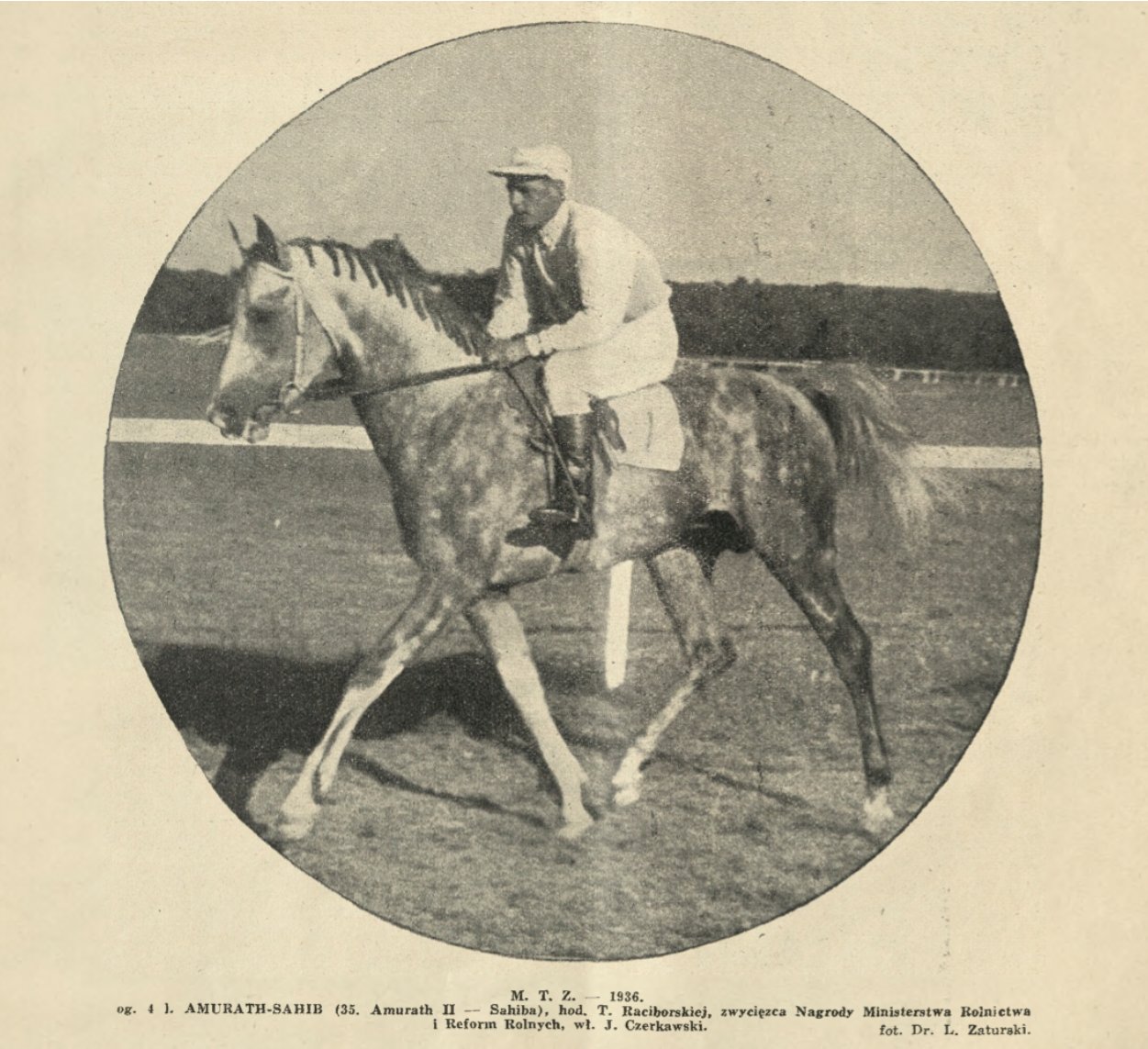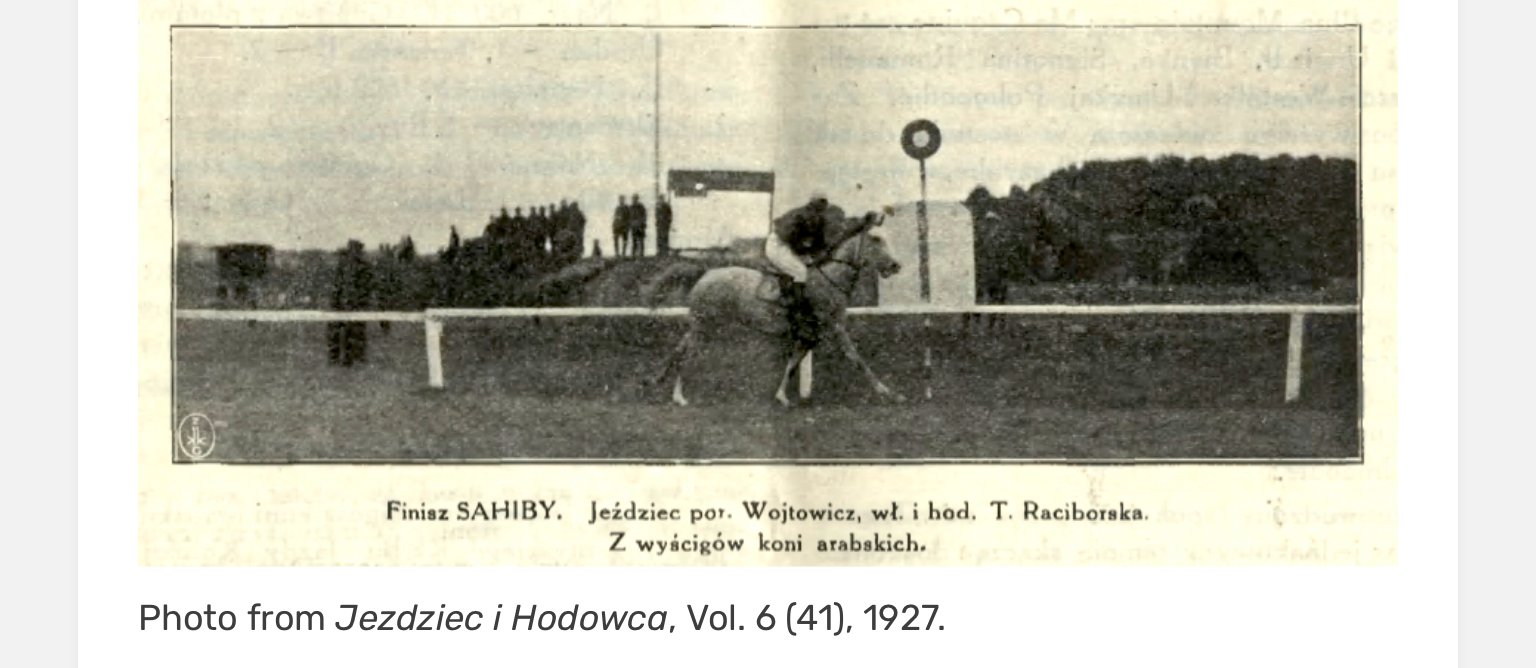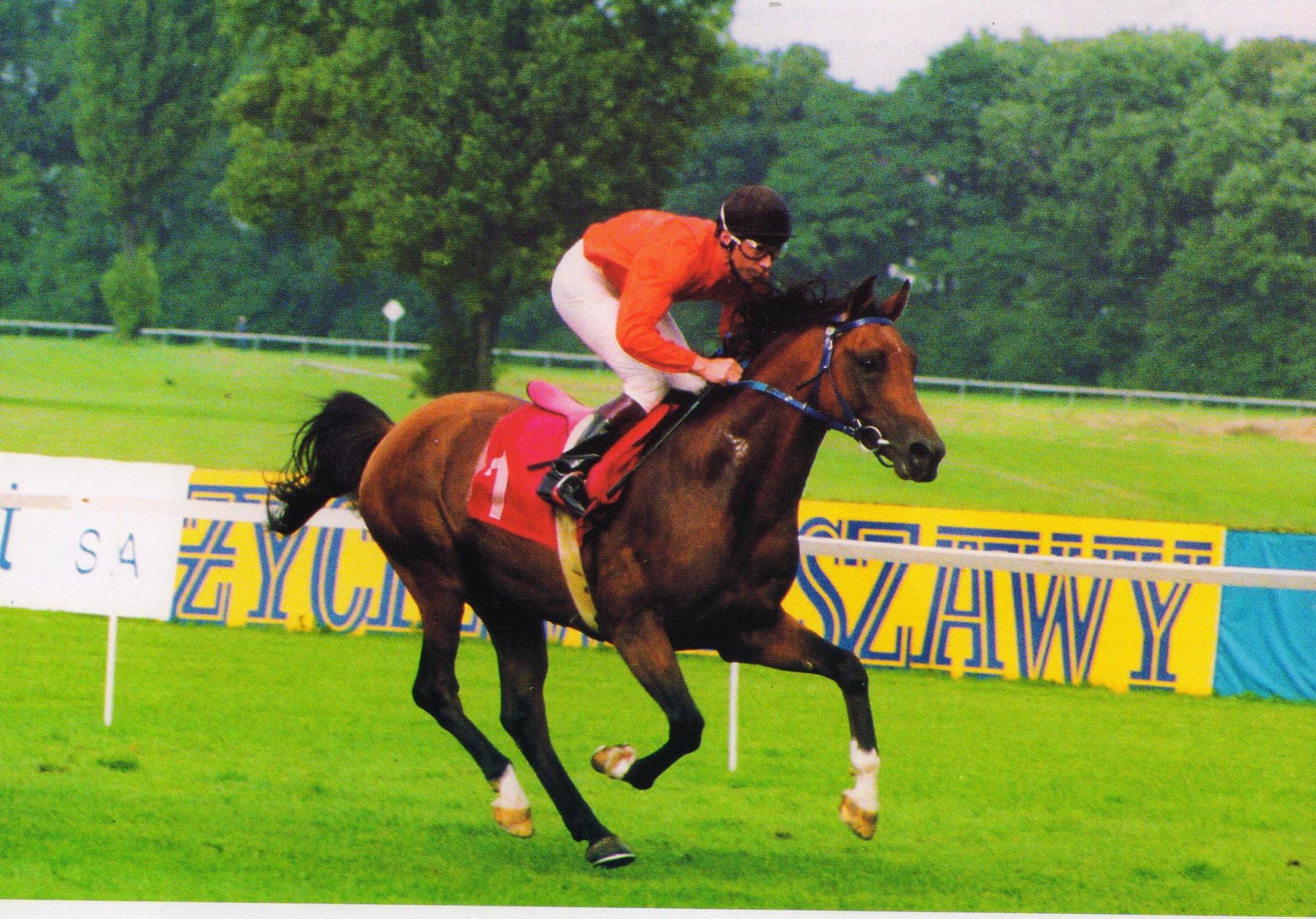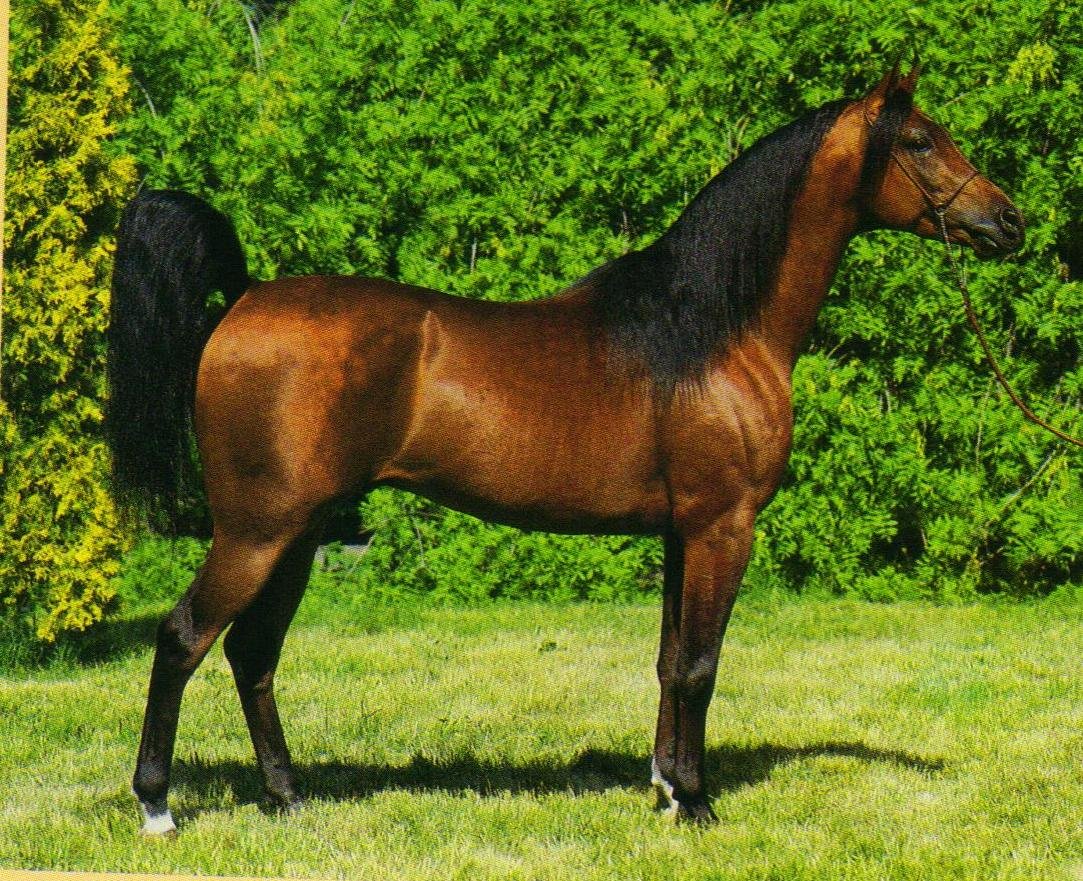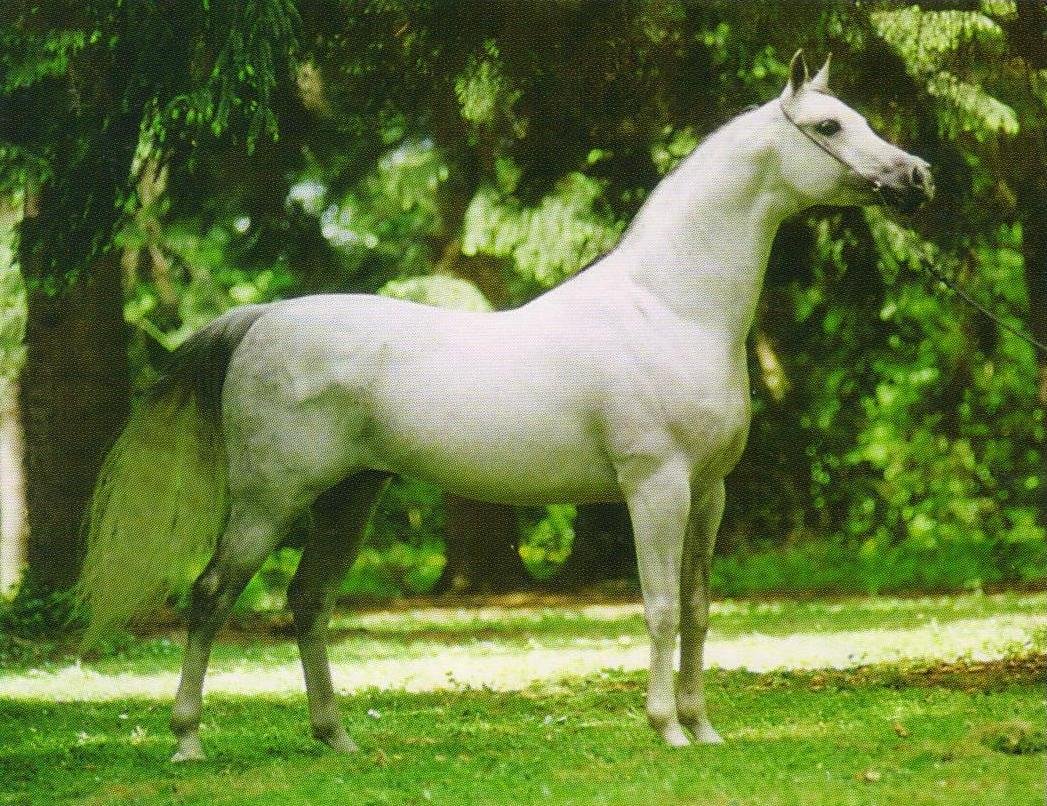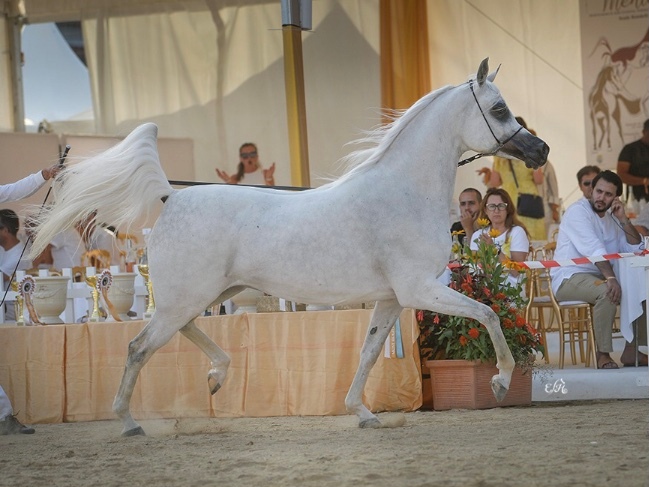Until recently, placing 3-year old Polish Arabian horses in race training was an undisputed prerequisite, considered on equal footing with the horse’s quality and beauty. However, that situation has changed, and Polish Arabian horses are now being ousted from Polish race tracks by horses unconnected with the Polish Breeding Program.
Purebred Arabian horse racing on flat track enjoys a long tradition in many countries, even as long as flat track Thoroughbred racing. Racing rules were formulated largely upon such rules in place for Thoroughbreds, while the country boosting great tradition in purebred Arabian horse racing is France. Since mid 19th century, races for purebred Arabian horses were organized in France with the aim of perfecting their ability to run a given distance at flat track. The main reason for breeding Arabian horses was to supply material necessary for the breeding of Anglo-Arabian horses, which was strongly developing in France.
In Poland, Arabian horses have always undergone bravery trials, serving in the past as military horses in the battlefield. They were also used as a vital means of transport, enabling to cross the vast expanses of Eastern borderlands.
Amurath Sahib 1932 (Amurath II-Sahiba po Nana Sahib I) breeder and owner Teresa Raciborska ,Breniów , as four-year-old, in racing condition. The picture from Jeździec i Hodowca.Vo.15(36),1936
The Arabian Horse Breeding Society was founded in 1926. Led by Aleksander Dzieduszycki, the Society proclaimed a Polish Breeding Program, which introduced systematic Arabian horse races, based on modern standards, as an integral component of that Program. Edward Skorkowski, a Polish hippologist, wrote the following words in his introductory note to Volume One of the Polish Arabian Stud Book: “In fact, the newly established Society provides a ground to bring our Arabian horses to perfection through joint effort. The means to achieve that goal are bravery trials, performed so as not to interfere with the genetic properties of the horse breed. Thus, it will be possible to select individuals really worthy to create a purebred horse."
Objectives and guidelines for bravery trials
Horse races as bravery trial for Polish Arabian purebred horses had different objectives than bravery trial for Thoroughbreds or Arabians in France. It was assumed already then that the main purpose of bravery trials is not to achieve maximum speed, but to select horses for bravery, health and endurance. Furthermore, bravery trials exposed the Arabian horse to necessary training, which prevented it from becoming excessively delicate. According to Witold Pruski, a specific beauty and high nobleness of the "Arabian horses was valued in Poland, combined with the characteristic bouquet of their refined silhouettes, dry, raw boned heads with a straight, or even slightly concave profile, big-eye sockets and big, expressive dark eyes, finished by thin layered skin covered with silky, shimmering fur. This peculiar charm of the Arabian horses was additionally enhanced by their beautiful, a little rounded movement."
Guidelines for the program of Arabian horse races set out by Bogdan Ziętarski paved the way for regulations governing horse races that have been in place for many years. That program remains up to date even today. According to the above guidelines, bravery and utility trials for Arabian purebred horses in Poland were based on Arabian purebred horse races that tested the horse’s bravery and utility. Horse races were not aimed at selecting horses for speed. Considering the fact that the Arabian purebred horses are late maturing, it was assumed that they will start the season in August as 3 years old, while competing only in their own age category. In order to protect the developing organism from overstrain, the horse was not allowed to start more than six times per season. The most demanding races, such as classical Derby or Oaks were to be run only by 4-years old horses. The weight carried by the Arabian purebred horse was increased as compared with Thoroughbred, spring distances were set within the range 1600-2400 m, and autumn distances till 3200 m. The end of the season was dedicated for races comparing different age categories, while financial subventions were established at a level that ensured the profitability of training. Horses were running in a group system and the classical prizes were Derby (4 years old stallions and mares – 2400 m) and Oaks (4 years old mares – 1600 m).
The objective behind races for Arabian purebred horses consists in proving their strength and resistance. Speed is of lesser importance. Due to the character of bravery trials for Arabian purebred horses, longer distances are required as well as heavier loads (weights).
Sahiba 1924 (Nana Sahib I-Dońka po Schechan-Schammar or.ar.) breeder and owner Teresa Raciborska, Breniów , photo from Jeździec i Hodowca, Vol.6(41), 1927
The principles worked out by Ziętarski may be presented by the following points:
1. Trials on short distances (below 1600 m) are excluded,
2. Start under heavier weight than Thoroughbreds,
3. Put to training as 3 years old (one year later than Thoroughbreds),
4. Participation in main races such as Derby at the age of 4 (Thoroughbreds at the age of 3).
Thus defined objectives of horse races were intended to test the individuals in a comprehensive manner, but also to strengthen and consolidate certain features that distinguished the Arabian purebred horse from other horse breeds, namely an iron strong constitution and endurance, dryness of the tissue, harmonious and correct conformation, as well as general resistance, both physical and psychological. Long distance races also allow a better appraisal of the horses’ health and endurance, thus enabling the determination of their aptitude and ability to perform in equestrian competitions, such as horse rallies or marathons.
Beautiful and brave
Authors of the Polish program developed in the twenties of the 20th century greatly valued and appreciated the results of the then one century long tradition of conscious and modern horse breeding on Polish territories. Therefore, they formulated a principle that the fundamental objective of horse races was to put horses to an obligatory bravery trial. This, in turn, created foundations for the successes of the Polish Arabian purebred horses in the near future. Thanks to ardent work of generations of horse breeders, supported by selection based on bravery trials, beauty and correct conformation of the horse, the Polish Arabian purebred horse gained the reputation of beautiful and brave and an undisputed primacy in the world.
Due to a clearly outlined aim behind horse breeding, which was to produce an Arab horse endowed with a specific bouquet and utilitarian features, such as beauty and bravery, for many years the Polish breeders harbored a conviction of the necessity to train and prove horses on racetrack.
“But the idea of taking them to the racetrack to prove them, their mind, their ability was a good idea, especially in Poland because you don’t’ have many people riding their horses. If you go to America, you will see how many performance classes we have. If you breed Arabian horses only to win in halter what do you do with the ones that don’t’ win? What do you do with all the rest? So if you can’t ride them, it’s a problem” – Raymond Mazzei.
Most Arabian horses bred in Poland were proven on racetrack, which resulted in the fact that mares developed in size and became healthy, while stallions developed their muscles and strength. Weaker individuals, with movement restrictions and poor performance were eliminated from breeding. The feature of bravery underwent steady consolidation in the population of Polish Arabian horses. Therefore, Arabian horses considered by man at a given time as beautiful were also brave.
Saszetka 1977 (Engano-Sasanka po Alimfar) Janów Podlaski , racing records, 2(11(6; D,O; 6,59-1,0-II, author D.Kędzierski
Arabian horses on racetrack
Over the years, the proportion of natively bred horses running on racetrack started to decrease, from over 90 percent in 1948 till merely 27 percent in the years two thousand.
Table 1
|
Year
|
Number born
|
Number running on
|
track
|
|
|
|
Pcs.
|
%
|
|
1948
|
32
|
30
|
93,75
|
|
1977
|
107
|
89
|
83,18
|
|
1992
|
169
|
134
|
70,28
|
|
2007
|
633
|
175
|
27,65
|
Due to strict adherence to the regulations established by state horse breeding, a monopolist in breeding Arabian horses from the end of World War II till 1989, the proportion of horses from a given year undergoing bravery trial was high. As indicated in Table I, during the postwar years most horses were running on racetrack put to bravery trial. Even in 1992 that proportion attained ca 70 percent. Yet, from 2007 when the said proportion was no more than ca 27 percent, a drastic downward trend is noted. The decreasing number of horses proven on racetrack is caused by several factors acting in synergy. The first and foremost reason is the structural change in the ownership of the Arabian horses. Now only 200 out of 600 Arabian horses born in Poland every year belong to state studs. Instead of one state breeder in charge, we have currently many private breeders, who make their own decisions affecting the career of their horses. Increasing cost of race training, coupled with inadequate prize sums, as well as the desire to adopt breeding trends prevailing in the world and to promote the presence of Polish Arabian horses on show rings, all these factors influenced the decision of many owners not to send their horses on racetrack. Another important reason is the departure from rules formulated in the Polish Breeding Program and the use of sires from lineages not included in that program. These newly introduced lineages have been selected for speed since generations, with the resulting loss of beauty characteristic for the Arabian horse. Under such circumstances, horse races no longer fulfill the function of bravery trial for the population of the Polish Arabian horses.
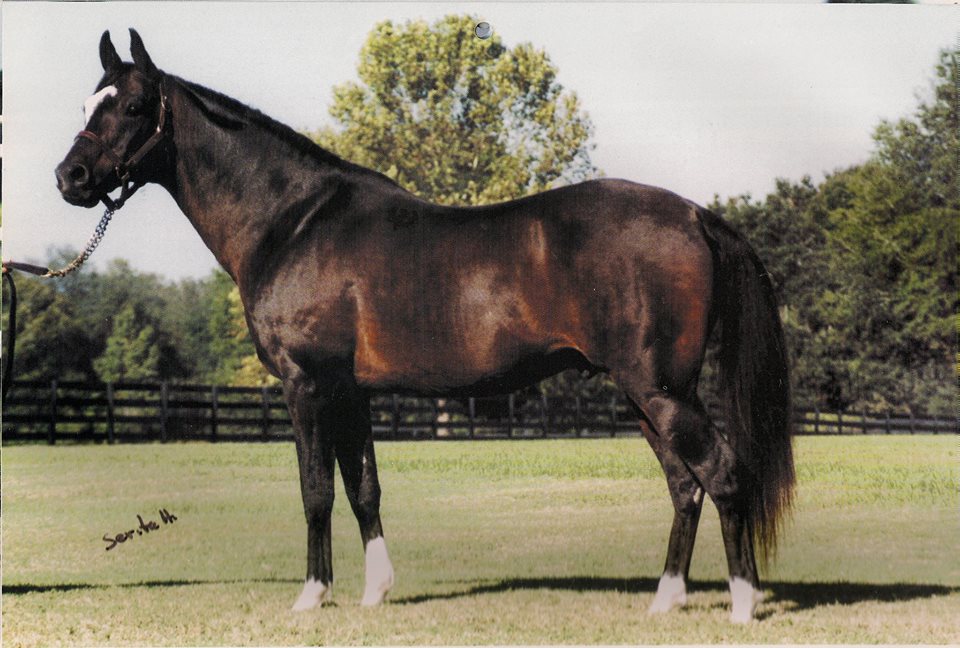
Wiking 1979 (Etap-Wilma po Pietuszok) breeder Janów Podlaski ,racing records 3(19(8 4,40-0,6-III, photo arch.
Because of their specialization in running, foreign-bred horses participating in horse races constitute a threat to stallions representing the Polish type. As all Arabian horses born in Poland are admitted to horse races, disregarding the origin of their parents, Polish Arabian horses, always bred under a specific breeding program and displaying visibly different features, now have to compete with the offspring of sires bred under a different program favoring selection for speed on flat racetrack.
According to the ranking of sires per prize sums won by offspring in the season 2019 (Table 2), first places were taken by stallions from the sire lines Amer or.ar, Latif or.ar. Telmese or.ar. and Tiwaiq or.ar., all of them not included in the Polish breeding program.
Table 2. Ranking of sires per price sums won by offspring
|
No.
|
Place acc,to sum*
|
Stallion name
|
Stallion lineage |
Number of offspring |
Sum PLN
|
Average PLN per offspring
|
|
1
|
3
|
Nashwan Al Khalidiah
|
Tiwaiq
|
2
|
138020
|
69010.00
|
|
2
|
13
|
Tabarak
|
Amer
|
1
|
60080
|
60080.00
|
|
3
|
6
|
Portmer
|
Amer
|
2
|
107450
|
53725.00
|
|
4
|
17
|
Akbar
|
Latif
|
1
|
45985
|
45985.00
|
|
5
|
11
|
General
|
Amer
|
2
|
66150
|
33075.00
|
|
6
|
22
|
Pentagon
|
Latif
|
1
|
27180
|
27180.00
|
|
7
|
25
|
Darweesh
|
Amer
|
1
|
23220
|
23220.00
|
|
8
|
30
|
Djoury du Monteil
|
Telmese
|
1
|
20900
|
20900.00
|
|
9
|
32
|
Chndaka
|
Latif
|
1
|
20310
|
20310.00
|
|
10
|
2
|
Nayef Al Khalidiah
|
Latif
|
11
|
216840
|
19712.73
|
|
11
|
1
|
Dahess
|
Amer
|
14
|
273340
|
19524.29
|
|
12
|
19
|
Jalnar Al Khalidiah
|
Tiwaiq
|
2
|
38150
|
19075.00
|
|
13
|
5
|
Murhib
|
Amer
|
7
|
128005
|
18286.43
|
|
14
|
34
|
ByStival Kossack
|
Morafic
|
1
|
18000
|
18000.00
|
|
15
|
37
|
Dormane
|
Latif
|
1
|
16640
|
16640.00
|
|
16
|
7
|
Muguet de Pascade
|
Telmese
|
7
|
105665
|
15095.00
|
|
17
|
12
|
Jaafer ASF
|
Amer
|
4
|
60085
|
15021.25
|
|
18
|
39
|
Impact
|
Latif
|
1
|
14675
|
14675.00
|
|
19
|
40
|
Njewman
|
Telmese
|
1
|
14420
|
14420.00
|
|
20
|
41
|
Kasih
|
Amer
|
1
|
14160
|
14160.00
|
Admitting Arabian racing horses to competition broke the fundamental principle underlying horse races in Poland, being the performance of bravery trials by Polish Arabian horses. The resulting prize money was meant to support the development of the Polish Breeding Program. Prize sums won by offspring of stallions not included in the Polish breeding program did not serve that purpose, against the intentions of the legislator. Consequently, for those breeders who wish to put their horses on racetrack, it does not pay to use stallions recommended by the program. Foreign-bred horses, or even those bred in Poland, but outside the framework of the Polish Breeding Program, cannot be considered as healthy competition for Polish Arabian horses bred under the program. Healthy competition exists only if we compare populations bred for the same purpose. The basic objective behind bravery trials was not to select the Polish Arabian horses for speed, but to eliminate individuals useless in breeding due to inadequate bravery; thus, such a horse need not be fast, but enduring in distance, healthy and well balanced.
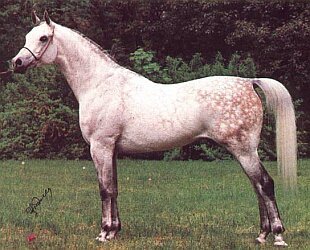
Pamir 1984(Probat-Parma po Aswan) Janów Podlaski, racing records, 2(11(5,D , 7,34-0,8-II, author Z.Raczkowska
Rescue efforts
Efforts were made to remedy that situation through increasing minimal distances, as well as restricting participation in horse races only to horses registered in the Polish Arabian Stud Book. However, these proved to be half measures only. Offspring of imported stallions born in Poland could be registered in the Polish Arabian Stud Book. Compared with their ancestors, such offspring displayed greater resilience in adapting to distances, yet losing in the process almost entirely the features characteristic of the Polish Arabian horse. Competition on racetrack became an end in itself, while the selection trial on racetrack ceased to fulfill the function of a bravery trial for Polish Arabian horses. Instead, horse races started to serve merely as an arena for spectacle. It turns out that the Poles themselves do not respect their own breeding program. That program clearly listed the lineages of horses that were allowed to be put to selection through participating in horse races, prized by funds from the Polish State Budget. The above listed foreign lineages are not among them.
Consequently, a large number of horses, produced for show rings, so to speak, never reach the racetrack. Those who do, have to compete with offspring of stallions selected for speed throughout generations. As a result, the Polish Arabian horse, hitherto synonymous to correct conformation and features connected with bravery, is slowly passing into history.
The return to strict observance of the Polish breeding program seems the only way to change that unfavorable situation, which also entails a return to the treatment of horse races as a selection trial for the Polish Arabian horses.
* Nothing stands in the way for horse races to become also a sporting event intended to all types of horses – yet, such horseraces need to be run separately from horse races fulfilling the function of selection trial.
The ranking of sires per the number of racing offspring indicates a limited participation of Polish sire lines in horse races. Even though the male lineage of Kuhailan Haifi was first in terms of participation, which also found reflection in the ranking of prize sums won, these sums were so low that the said lineage took merely 37th place in terms of prize sums per horse.
Druid 1993 (Wojsław-Dalida po Probat ) Michałów, racing records; 2(12(11, D, AP, JP; 20,60-0,7-II
Table 3. Ranking of 10 sires per the number of racing offspring
|
No.
|
Sire name
|
Lineage |
Country
|
Place by prize sum
|
Place by prize sum per offspring
|
Number of racing offspring |
|
1
|
Ontario HF
|
Kuhailan Haifi or.ar.
|
US
|
4
|
37
|
21
|
|
2
|
Von
|
Telmese or.ar. 1903
|
DE
|
9
|
48
|
17
|
|
3
|
Pogrom
|
Saklawi I (Morafic)
|
PL
|
16
|
64
|
14
|
|
4
|
Dahees
|
Amer or.ar.1984
|
GB
|
1
|
11
|
14
|
|
5
|
Dostatok
|
Latif or.ar. 1903
|
RU
|
10
|
39
|
14
|
|
6
|
Kazbek
|
Latif or.ar. 1903
|
RU
|
18
|
60
|
11
|
|
7
|
Nayef Al Khalidiah
|
Latif or.ar. 1903
|
SA
|
2
|
10
|
11
|
|
8
|
Vitorio
TO
|
Mirage
or.ar. 1919
|
US
|
20
|
65
|
10
|
|
9
|
Mared Al Sahra
|
Amer or.ar.1984
|
GB
|
8
|
25
|
9
|
|
10
|
Vasyli Kossack
|
Latif or.ar. 1903
|
NL
|
15
|
47
|
9
|
|
|
|
|
|
|
|
130
|
*bolded in the Polish Breeding Program
Table 4 shows the number of horses from sire lines included in the Polish Breeding Program starting on Polish racetracks, being only 57 horses out of the total of 332 horses starting. These data reveal the departure of Polish horse races from its objective, being bravery trials for horses bred under the Polish Breeding Program.
Wojsław 1986 (Tallin-Wilejka po El Paso ) Michałów, racing records; 2(15(4, 1,52-0,7-I
Table 4. Ranking of male lineages per the number of representatives starting
|
No.
|
Mare lineage
|
Number of starting |
horses
|
|
1
|
Latif or.ar. 1903
|
101
|
|
|
2
|
Sakalwi I*
|
67
|
|
|
3
|
Amer or.ar. 1984
|
53
|
|
|
4
|
Kuhailan Haifi or.ar.
|
|
35
|
|
5
|
Telmese or.ar. 1903
|
30
|
|
|
6
|
Ibrahim or.ar.
1899
|
|
12
|
|
7
|
Mirage or.ar.
1919
|
10
|
|
|
8
|
Tiwaiq or.ar. 1982
|
7
|
|
|
9
|
Kuhailan Afas or.ar. 1930
|
|
6
|
|
10
|
Felhaan Alshawaf BH
|
3
|
|
|
11
|
Ilderim or.ar.
1894
|
2
|
|
|
12
|
Koheilan Adjuze or.ar.1876
|
|
2
|
|
13
|
A Seglavi Jedrani
|
1
|
|
|
14
|
Bairactar
or.ar.1813
|
|
1
|
|
15
|
Krzyżyk or.ar.
1869
|
|
1
|
|
16
|
Jamil el Kebir or.ar. 1873
|
1
|
|
|
|
Subtotal
|
275
|
57
|
|
|
Total
|
|
332**
|
*all lineages in the line Saklawi I
** number of all Arabian horses starting on Polish racetracks, Warszawa and Wrocław
Emigrant 1991(Ararat-Emigrantka po Eukaliptus) Michałów racing records; 2(22(1; 0,75-I
The above Table clearly shows that horse races in Poland cease to play a role subordinate to the Polish Breeding of the Arabian horses, contrary to the original assumption that horse races were to provide ground for bravery trials and the improvement of native breeding.
Looking at the changes taking place in the Polish breeding, already in 2008 Raymond Mazzei expressed his anxiety, stating the following words in an interview granted to Monika Luft: “For me Polish horses or any good Arabian horse has to be a horse that can be raced or ridden. So, what will you do when it is time to get Psytadels and Enzos to the racetrack? No more racetrack? Then you will be in the same position that America is in. You will have the cannon bone the same length as the forearm, you will have bad feet and you will have a big poodle to run around in the show ring. Not a horse. You can have a big poodle (….). Now we are on a good way to destroy the Arabian horse because it is not being ridden. In Poland the Arabian horse breed will degrade due to the lack of horse races.”
Summary of the problem
Intensive use in breeding of specialized sires and improving performance of the Arabian horse breed in running short distances at flat track raise reflections as to the rationale behind such actions. What is the point in so doing if that feature has been developed to perfection in Thoroughbreds, a horse breed unsurpassed in that respect. Hence, if there exists a demand for fast horses, then the Thoroughbred horse fulfills that demand. Furthermore, that horse breed still performs the function already abandoned by the Arabian horse breed, namely acting as improvers of half-breeds. And yet, although breeding of Arabian racing horses has its proponents worldwide, in Poland the Arabian horse has never been bred in this one-sided direction, while perfecting the feature of speed should take place in accordance with the objectives of the Polish breeding program within a comparable population. Perfecting the feature of speed as the preferable feature must lead to a weakening, and a resulting loss of features hitherto inherent in the Arabian horse breed, such as beauty, connected with a widely understood bravery. Breeders of Arabian horses bred for show purposes eliminate race training from their development program dedicated to young horses. In this way, they avoid the confrontation of their horses on racetrack and the inevitable costs of race training. Likewise, the so called Arabian racing horses are not evaluated for conformation. Therefore, it must be emphasized once again that the main objective of breeding the Polish Arabian horses is perfecting the breed for such features as increased beauty and dryness of tissue, while maintaining the remaining, valuable traits of the Polish Arabian purebred horse, i.e. correct conformation, perfect movement and outstanding utilitarian features resulting from bravery trials on racetrack.





